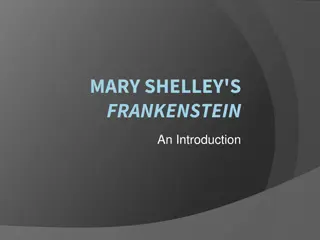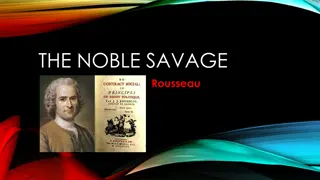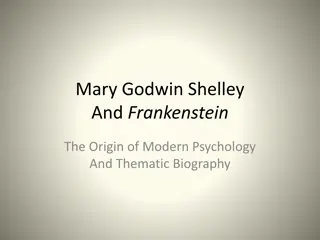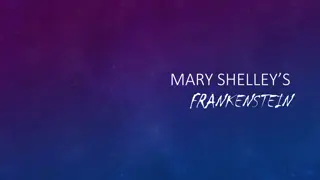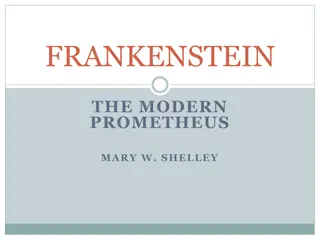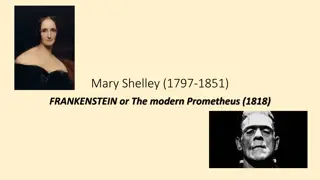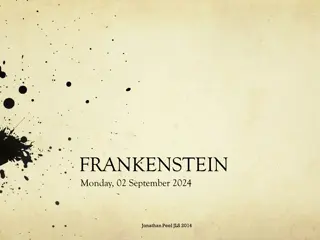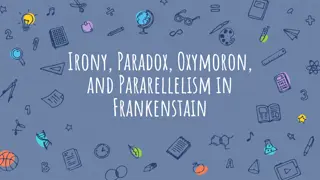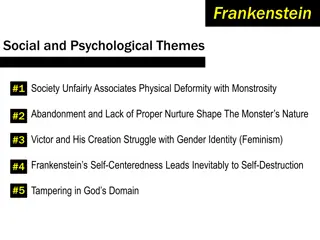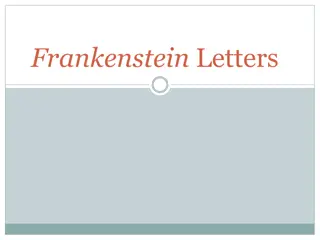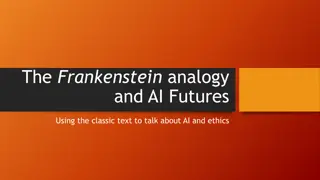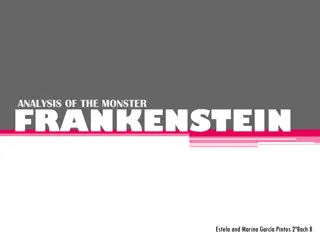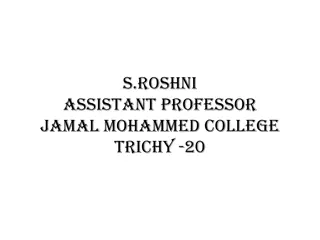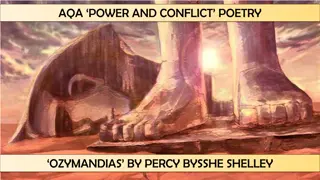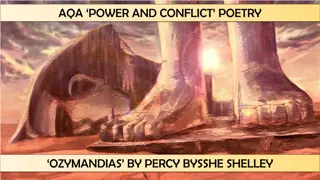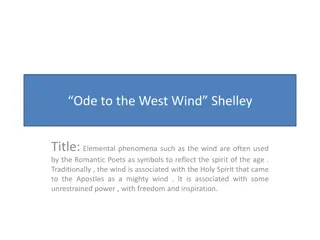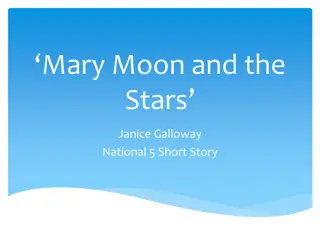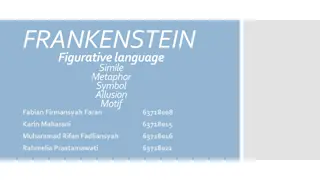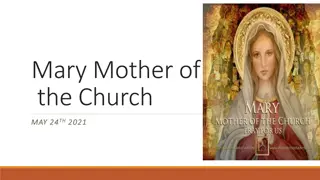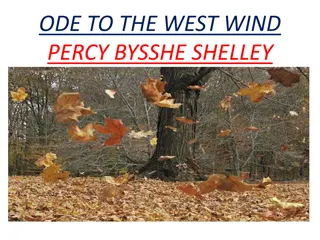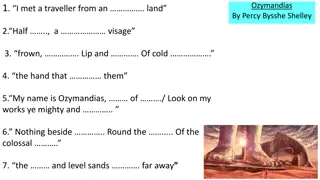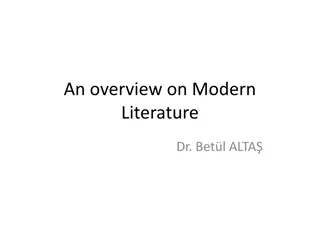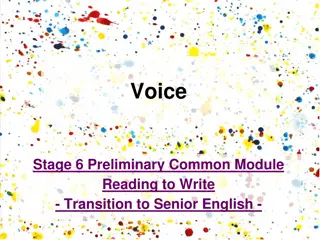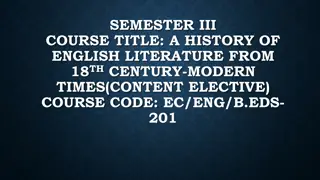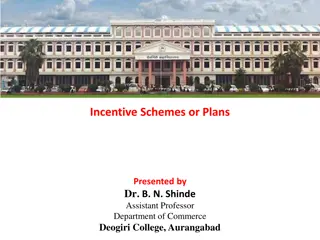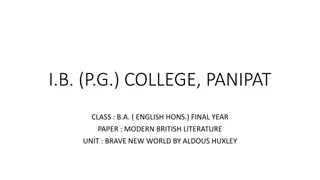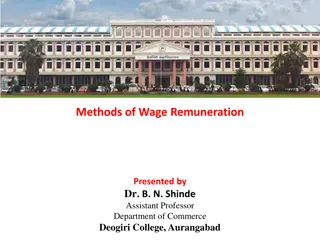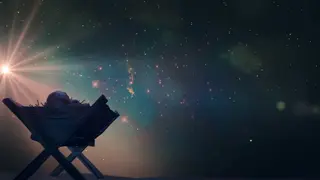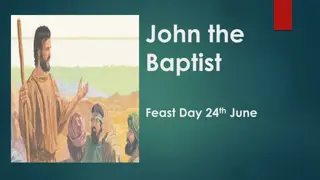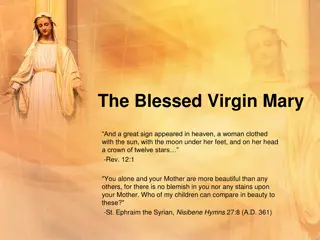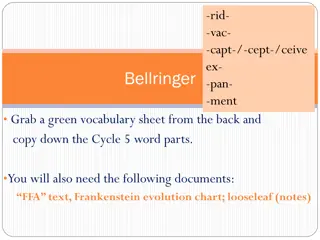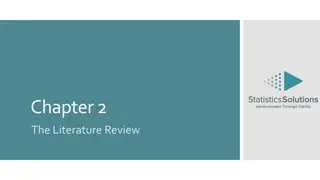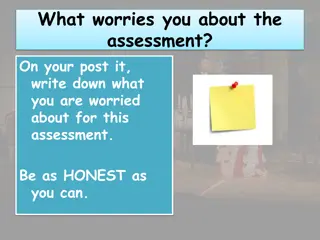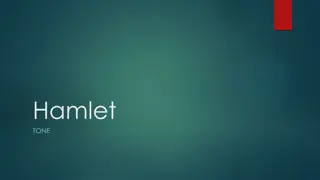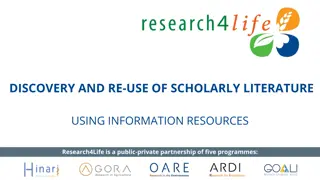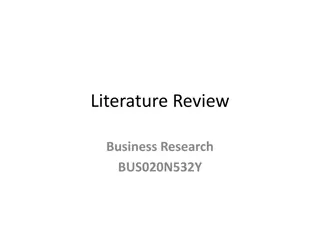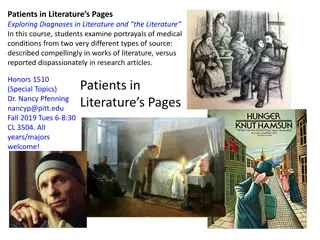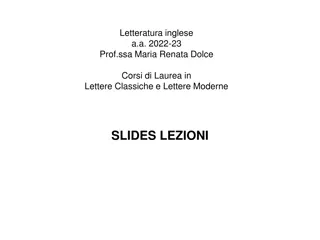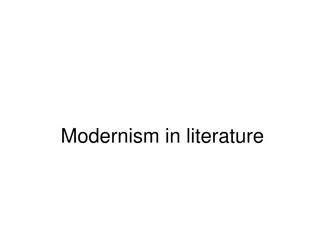Analysis of "Frankenstein" by Mary Shelley as a Modern World Literature Piece
"Frankenstein" by Mary Shelley, published in 1818, tells the story of Victor Frankenstein and his creation. The narrative unfolds through letters, revealing themes of creation, responsibility, and societal rejection. The novel delves into complex moral questions and explores the consequences of unchecked scientific ambition, making it a significant work in modern world literature.
Download Presentation

Please find below an Image/Link to download the presentation.
The content on the website is provided AS IS for your information and personal use only. It may not be sold, licensed, or shared on other websites without obtaining consent from the author. Download presentation by click this link. If you encounter any issues during the download, it is possible that the publisher has removed the file from their server.
E N D
Presentation Transcript
Frankenstein, by Mary Shelley How is the text a piece of modern world literature?
Text Summary (Published in 1818) Narrative is told through R. Walton, who is travelling to the Arctic for the sake of seeing whether it is possible. The first part of the novel is told through a series of letter from Walton to his sister. In the narrative, Walton rescues Frankenstein onto his boat, and Frankenstein tells his story, which forms the majority of the rest of the novel, and is in prose chapter form. Frankenstein was born in Geneva, and travels to Ingolstadt (modern day Germany) receive his education. He is ridiculed for his readings of Cornelius Agrippa, who was a philosopher writing in the early 1500s. During his studies he becomes fascinated with the idea of the principle of life and the structure of the human frame. He discovered what is needed to create life (electricity), and sets about creating a being to animate. However once he has animated his creation, he becomes horrified by what he has created and flees his apartment.
When he returns with his friend Henry Clerval, to his relief the creature has gone. Frankenstein then falls terribly ill with the guilt and horror of what he has done. After a considerable time, he recovers and plans to return to his family in Geneva. He then receives a letter from his father informing him that his younger brother William has been murdered. On his return to Geneva, Frankenstein sees the creature in a flash of lightning, and at that moment is convinced that the creature murdered his brother. When Frankenstein returns home, he is informed that William has allegedly been murdered by Justine, a family friend. She is killed for the crime, and Frankenstein feels the guilt for her and William's deaths.
Frankenstein then goes travelling to Chamonix, and climbs in the mountains, where he meets his creature. The creature entreats Frankenstein to listen to his story, which is then followed by the creature's first person narrative perspective. The reader learns how the creature struggled to survive at first, and how it was met with horror and disgust wherever it tried to find food or shelter. It then found a small cottage and formed a unreciprocated "relationship" with the family that lived there, and through them learnt words and speech, and teaches himself how to read. He performed helpful tasks for them, such as collecting firewood, and eventually has the courage to approach them. He speaks first to the father, who is blind, but their civil conversation is disrupted and ruined by the arrival of the son, daughter, and the son's new wife. These three are repulsed by the creature and drive it from their home. In the following days they leave the cottage and in its anger and sense of betrayal, the creature burns the cottage. The creature then decides to search for its Creator, as they would be the only person who would be obliged in some way to interact with it.
The creature arrives in Geneva and rescues a girl from drowning in a river, but instead of receiving thanks the girl's male companion shoots him. This causes much anger, and the creature exclaims "This was then the reward of my benevolence!" "The feelings of kindness and gentleness which I had entertained but a few moments before, gave place to hellish rage and gnashing teeth." It is in this spirit that the creature confronts a small boy, who the reader knows to be William, and when William says that his father is called Frankenstein, the creature kills him as William is the kin of his enemy. The creature then takes the small portrait from William and later leaves it with Justine, to frame her for murder. The creature ends his tale by telling Frankenstein that he must create a female companion for him, which Frankenstein later promises to do, as the creature promises to leave human civilisation and go to some uninhabited region.
To complete this task, Frankenstein travels to London with his friend Henry, and later to a remote island in Scotland. He is overcome with the horror of what he is about to do, and then refuses to create a female companion, as then they could reproduce to create many more horrific creatures. The creature is enraged by this and tells Frankenstein "I will be with you on your wedding night." Frankenstein then leaves the island and tries to return to the mainland, but is set off course and ends up in Ireland, where he is accused of murder. The victim turns out to be Henry, as the creature continues its destruction of Frankenstein's friends and family. Frankenstein is eventually freed from prison, and returns to Geneva where he marries Elizabeth. On their wedding night, the creature stays true to his word and murders Elizabeth. The news of this reaches Frankenstein's father and he dies from the shock and heartbreak.
Frankenstein then resolves himself to pursuing the creature to avenge his wife (and his entire family). This takes him on a journey north through Russia towards the Arctic, which is where Walton meets him. The narrative is now back up to date, and returns to Walton's letters. The boat becomes trapped in ice, and the men convince Walton to turn southward if the ice clears. Frankenstein is opposed to this, as he wishes to continue north to find the creature, but he falls ill yet again, this time fatally. He entreats Walton to continue his mission and kill the creature if he finds him. Upon the death of his Creator, the creature appears, and is apparently mournful as his purpose for existing has gone. The creature then declares that he will kill himself, and vanishes from the boat.
Modernity in the text Break from the past The science in the novel - the innovation of discovering the cause of life. Frankenstein breaks away from the norms of science for his time. Science was at a frontier point when Shelley wrote Frankenstein, and so as well as being a ghost story, she set it out to be "A cautionary tale warning of the dangers that can be cast into society by a presuming experimental science." The novel itself is a break from the past - is arguably one of the first works of science fiction, as it involves the manipulation of science to create a fantastical result. Tory Quarterly Review gave Frankenstein a venomous review, saying it was immoral and failed to give a lesson of "conduct, manners or morality". Tory paper and therefore Conservative publication - if it angers this then Frankenstein is arguably a break from the traditional and is therefore modern?
Modernity in the text Space time compression Time compression in Victor's creation of the creature, takes the childhood aspect of life away and gives the creature immediate adulthood. (This also matches the time is always "out of joint" aspect of modernity) Global travel of Frankenstein and Walton, how travelling to previously unknown or rarely visited places was becoming easier to accomplish.
Modernity in the text The rise of the everyday Present in the lives of the cottage dwellers, and the creature's attempts to become acquainted with the workings of human existence - eating, speech, etc. Novel is about the impact of creating life, rather than focusing on how it was done - therefore Frankenstein is about emotional and psychological impacts, and the effect on individuals. Examples: -The creature's various existential crises as he questions why he exists and why he was created. - Frankenstein's own guilt at what he has done.
Modernity in the text Experience of fragmentation, displacement and dispersal Fragmentation the creature feels, in its agony of being separate from normal humanity. Displacement from various groups and places that it hopes it would be welcome (i.e. The first village it comes to, and then the cottage where its friends live.) Isolation that Frankenstein feels after the creation of his first creature, and then when the creature demands a mate. Fragmentation of Frankenstein's own personal life as all of his family, friends and loved ones die due to his creation.
Modernity in the text Written by a woman, who is arguably a modern woman Mother was Mary Wollstonecraft, feminist and philosopher, (who wrote The Vindication of the Rights of Women). Father was William Godwin, an esteemed political philosopher Both parents were influenced by the ideals of the French Revolution As a result of this strong philosophical and educated parentage, she received an unusually high education for a girl of her time. Father had high expectations for her, as she writes in her journal "To do something great and good was the precept given me by my Father." In a review of the novel from Blackwood s: For a man it was excellent, but for a woman it was wonderful which implies a lack of female writers, at least in this genre. Novel was published anonymously, and this was also around the time that the Bronte sisters, for example, published their novels under male pen names, showing how the genre of novel writing was not wholly accessible to woman.
Worldliness in the novel Lots of physical travelling in novel, set during a time of "The Grand Tour" of Europe, greater availability of European travel - Mary Shelley herself was travelling in Europe when she first conceived the idea of Frankenstein. Exploration -Walton, travelling to Arctic. Death in the novel was a present issue for Mary Shelley - three of her four children died, her mother died soon after she was born etc novel in part reflected her own time of living. Worldliness in the rise of the everyday aspect of modernity e.g. life of the cottage dwellers Discovering new facts and features of the world through scientific experiment, a different kind of exploration to Walton s.


